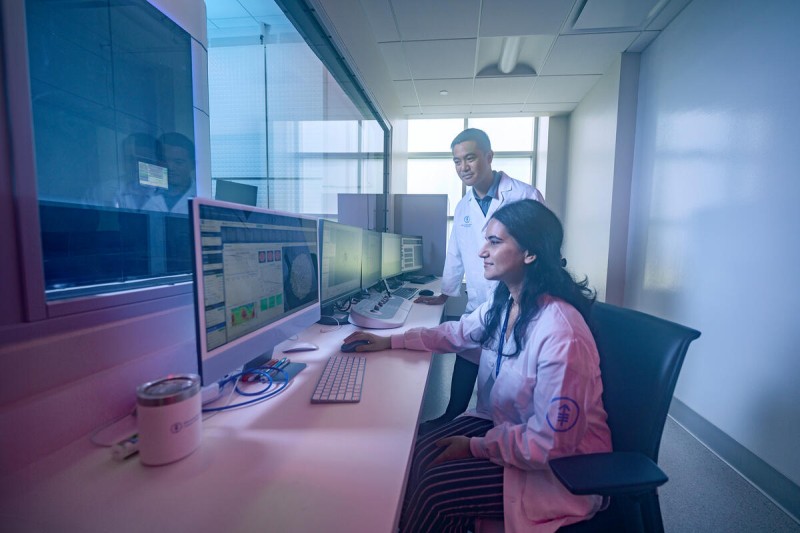
Researcher Ankita Dhar and facility manager M. Jason de la Cruz at work in MSK's cryo-electron microscopy facility, where MSK's new fourth-generation Krios microscope (far left, behind the glass) provides MSK scientists with an unprecedented view of the wild and wiggly microcosm inside our cells.
Boxy, sleek, and fronted with dark glass, it looks more like a 10-foot-tall wine fridge than a multimillion-dollar microscope. But this technological marvel is providing scientists at Memorial Sloan Kettering Cancer Center (MSK) with an unprecedented view of the wild and wiggly microcosm inside our cells.
Employing a technique called cryogenic electron microscopy — or cryo-EM, for short — MSK’s new fourth-generation Krios microscope fires electrons at two-thirds the speed of light toward samples that have been flash frozen at -180 C (-292 F). Cabinets full of high-powered computer graphics cards process the resulting data, producing 3D movies and frame-by-frame stills that capture fundamental biological machinery in action. With cryo-EM, MSK scientists can observe the most minute processes central to health and development, as well as those that have gone haywire in cancer and other diseases.
Compared with other techniques used to visualize the structure of proteins and protein complexes, cryo-EM offers the difference between seeing a schematic diagram of a combustion engine versus watching an engine as it’s running, and observing how it converts heat into mechanical energy, says structural biologist Stephen Long, PhD, a member of MSK’s Sloan Kettering Institute who helped oversee the microscope’s installation.
How Cryo-EM Works, in a Nutshell
How does cryo-EM work?

Dr. Stephen Long
Imagine, Dr. Long suggests, New York City viewed from above, with people going about their everyday activities. And from that bird’s-eye view, the people standing up might appear to be small ovals. People lying down would look long and thin. People in motion would have limbs jutting out at a variety of angles. But if one captured millions of snapshots of people in a wide variety of human activities, you would have enough information to work out the fundamental shape of a human — a head, a torso, and four limbs — along with the variety of ways in which the human body is capable of moving.
And it would be possible to study ways in which people interact with each other — how arms move and connect differently, for example, when shaking hands compared to high-fiving or arm wrestling.
It’s the same with the particles scientists look at using cryo-EM — whether it’s individual proteins or complexes of proteins at various stages of a particular biological process. The particles scattered throughout the flash-frozen sample are in a random assortment of positions. With some heavy lifting by scientists equipped with powerful computer processors, one can piece together a 3D model of a given protein or of multiple proteins interacting.
And researchers can stitch the still images together into 3D movies that show how all the parts of a cellular machine line up and interact.
Like ‘A Finely Tuned Racecar’
Christopher Lima, PhD, who chairs MSK’s Structural Biology Program, likens the new microscope to a Formula 1 racecar.
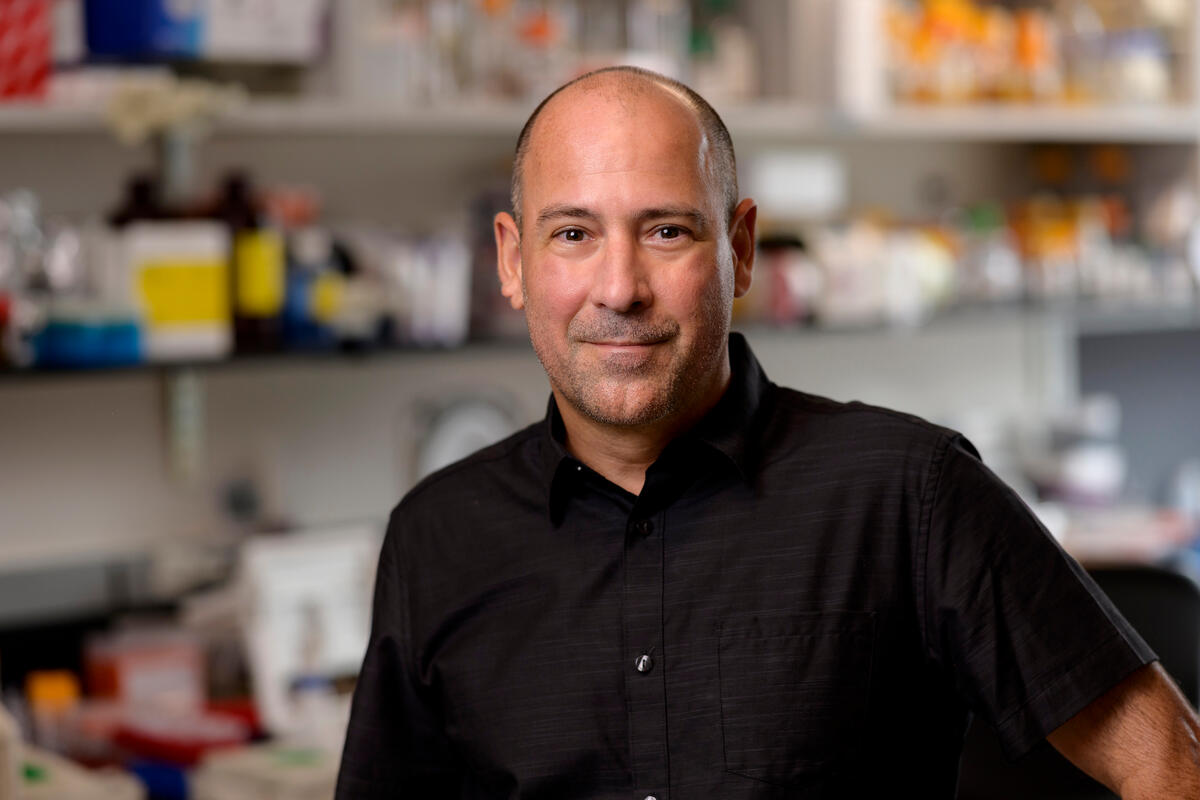
Dr. Christopher Lima
“It is a very high-end piece of machinery and has incredible performance, but like a finely tuned racecar, it’s also a little finicky,” he says.
Just as a shaky hand can blur a photograph, even the smallest vibrations or electrical fields can cause distortions when you’re shooting teeny-tiny electrons at the atomic particles in a sample to figure out its shape.
The new microscope and an earlier model that MSK purchased in 2016 are housed in special suites on the first floor of the Rockefeller Research Laboratories building. Here, they are shielded from electromagnetic interference, buffered against the vibrations of trucks and subways, and maintained at tightly controlled temperatures. Just being in the room for too long while the microscope is running can disturb the equilibrium.
The Cryo-EM Revolution Is Here, and MSK Is Leading the Way
The inside of our cells is a crowded bustle of activity. The discipline of structural biology focuses on understanding how the precise shape and movement of the squiggly proteins and biological machinery in our bodies affects their function. It can help researchers determine, for example, whether the action of a protein might be blocked or enhanced by docking a drug molecule to a particular part of it.
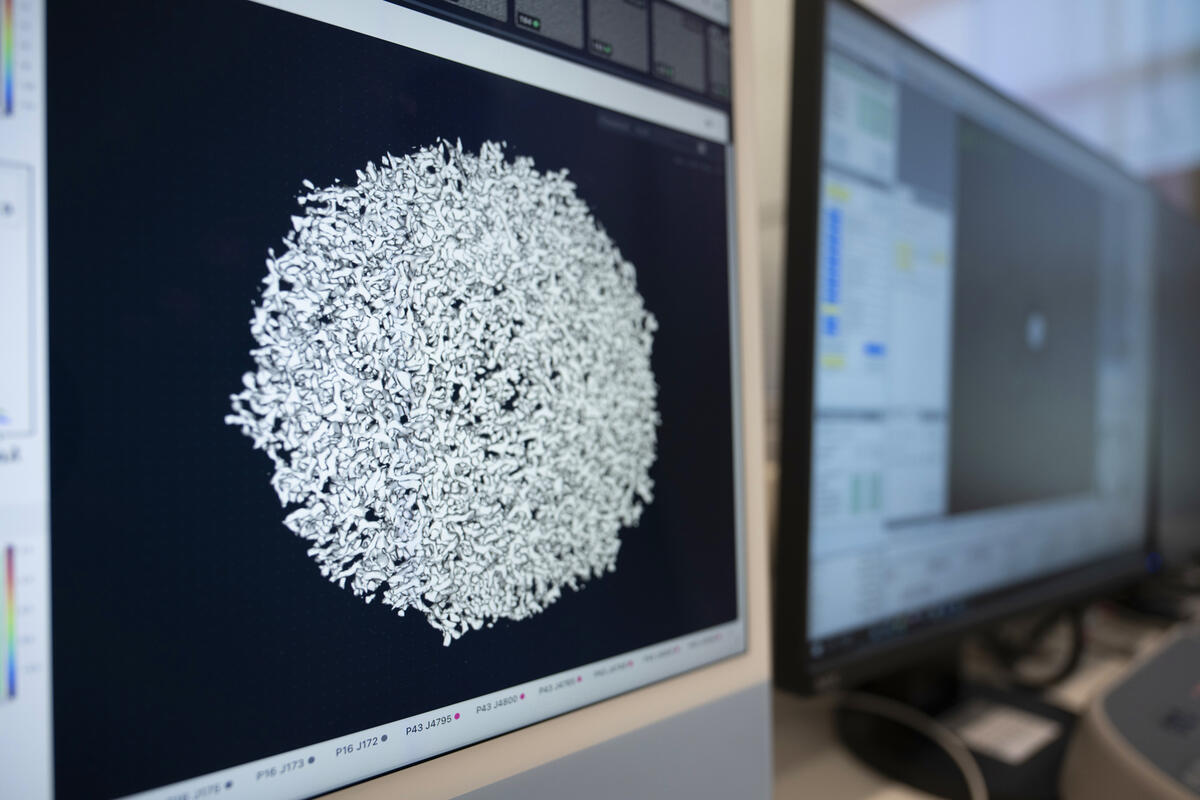
A close-up view of a protein complex obtained using cryo-EM.
Over the past decade, cryo-EM has rapidly changed the field, both at MSK and around the globe. In 2017, three researchers were awarded the Nobel Prize in Chemistry for the development of cryo-EM, and by 2020, the leading science journal Nature declared the revolutionary technology was “taking over structural biology” — swiftly gaining ground against the longtime gold standard for visualizing proteins: X-ray crystallography.
The particles the microscope illuminates are so tiny, scientists measure the image resolution not in millimeters or even nanometers, but in Ångströms. One Ångström — one-ten-billionth of a meter or one-tenth of a nanometer — is roughly equivalent to the size of an atom.
“When you’re able to achieve resolutions approaching two Ångströms, which the new microscope helps us to do, things really start to come into focus,” Dr. Lima says.
Another way to put the microscope’s magnification into perspective: If it was a telescope sitting on the surface of the moon, and you pointed it at the Earth, it would be powerful enough to read the date on a dime.
Expanding MSK’s Cryo-EM Capabilities
MSK’s first cryo-EM machine, a second-generation Krios, ushered in the cryo-EM era at MSK eight years ago. While the original microscope has been kept busy with projects from more than 50 investigators across MSK’s research programs, the new, more advanced microscope should more than double MSK’s capacity for cryo-based projects, Dr. Lima says.
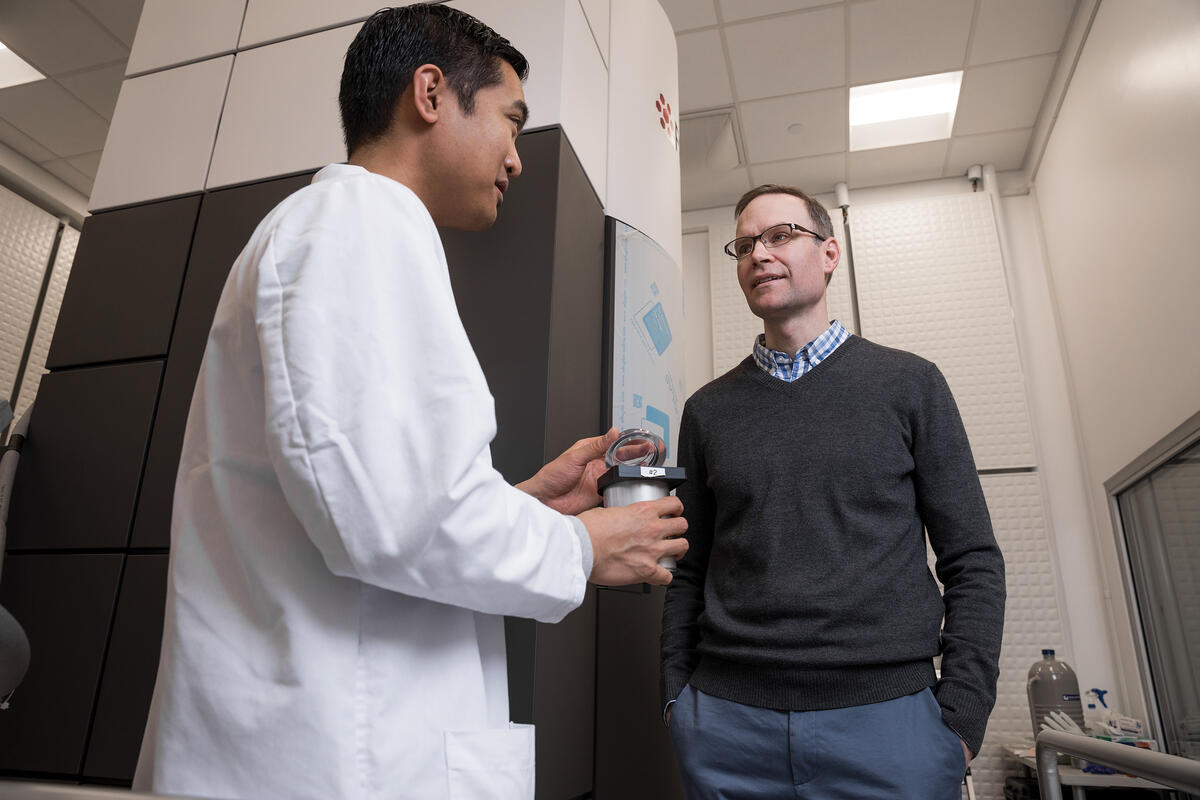
MSK’s first Krios microscope towers above cryo-EM facility manager M. Jason de la Cruz and Dr. Long in this 2018 photograph.
The new microscope has significant technological improvements that include a more stable beam that allows investigators to capture higher-resolution images and an improved energy filter to reduce image noise.
With the new Krios, MSK scientists will be able to achieve better resolutions with less data, Dr. Lima notes.
“That could be enough to distinguish whether we’re looking at a five-member ring or a six-member ring,” he adds, referencing variations in atomic structure.
MSK Cryo-EM facility manager M. Jason de la Cruz, has also been marveling at how fast the new microscope is.
“We’re now collecting more than 600 images per hour, whereas before it was around 320,” he says.
‘It’s Not Plug-and-Play’
The purchase of the new microscope and the renovations necessary to house it were made possible by a generous philanthropic gift from Barbara and Stephen Friedman through their Friedman Family Foundation.
“The ability to visualize molecules in their native habitat is opening our eyes to what occurs in cells and how they work,” Dr. Long says. “The more we know about these fundamental processes, the better we can manipulate them. This microscope will advance our understanding of key processes underlying both life and disease.”
But the microscope itself is just one part of the equation, he adds. “It’s not plug-and-play.”
The facility requires de la Cruz’s attention as a full-time manager, and users must have specialized training. And that doesn’t include the physical and data infrastructure it takes to keep the microscopes running.
The amount of data involved can be hard to wrap your brain around. A middle-sized iPhone has a storage capacity of 256 gigabytes — enough for about 100,000 12-megapixel photos. A cryo-EM microscope, which runs 24 hours a day, 365 days a year, generates 5 to 10 terabytes of data per day — or as much as 5 million iPhone photos. Over the course of a year, that can add up to more than two petabytes of data: that’s 2 million gigabytes, the equivalent of a billion selfies.
“When you think about it like that, you can imagine what it takes to manage, analyze, and store all that data,” Dr. Lima says. “The microscope itself is just the starting point.”
A recent study by Dr. Lima’s group highlights the intensive nature of the work itself. The team spent two weeks collecting data on MSK’s original microscope, but it took another year to process all of it.
“It takes that long because these systems are very dynamic, and you might have five different possibilities that could fit,” he says. “In some cases, only one is actually correct, in other cases all five are correct.”
The new microscope, he adds, will not only speed up the process and reveal more subtle details, it will allow MSK scientists to pursue more nuanced and complex questions than they could ask previously.
Moving Beyond Single-Particle Analysis
The bells and whistles on the new microscope will allow the researchers to move beyond traditional single-particle analysis to emerging techniques known as cryo-electron tomography (cryo-ET) and microcrystal electron diffraction (MicroED), de la Cruz notes.
With cryo-ET, MSK scientists will be able to study samples from the nanometer to the micron scale, and under conditions that more closely match the natural state of a cell rather than having to start with a purified protein. (A nanometer is equivalent to 10 Ångströms, while a micron is 10,000 Ångströms.)
MicroED, on the other hand, allows researchers to determine the structure of drugs or proteins using crystals that are too small for X-ray crystallography.
“The thing about crystallography is that you have to grow crystals,” de la Cruz says. “It can be challenging to get proteins to crystallize and to grow them big enough for X-ray methods. MicroED allows us to use crystal samples that are much smaller.”
Allowing Investigators to Ask New Questions
Cryo-EM isn’t just for the structure-focused researchers in MSK’s Structural Biology Program. MSK scientists across a wide range of disciplines are using it to build vital knowledge about health and disease.

Drs. Tobias Walther (left) and Robert Farese
“We are using the microscope to obtain structures and molecular functions of enzymes involved in the generation and breakdown of lipid droplets,” says Robert Farese, MD, a member of MSK’s Cell Biology Program, whose joint lab with program chair Tobias Walther, PhD, investigates cellular lipid and energy metabolism, and their role in diseases, including cancer. “Access to this instrument, and the tremendous help from the cryo-EM facility, has been key to enabling our rapid progress on these investigations.”
Meanwhile, Dirk Remus, PhD, a member of the Molecular Biology Program, has been collaborating with Richard Hite, PhD, of the Structural Biology Program, to use cryo-EM to study problems that occur during the duplication of DNA when cells divide, and which are a major cause of the genomic instability that leads to cancer.
“DNA replication is carried out by a large molecular machine, a large protein complex with dozens of subunits, called the replisome,” Dr. Remus says. “While traveling along DNA, it can encounter various obstacles.”
The collaboration has allowed their teams to “solve” the structure of replisomes that have stalled on a four-stranded DNA structure known as a G-quadruplex — which are believed to play a role in cancer growth and progression and are targeted by cancer therapeutics currently in development.
“So now that we can see precisely how that stall occurs, that can help us hypothesize how these problems might be overcome,” Dr. Hite says.
Dr. Lima’s research, meanwhile, has focused on the ubiquitin pathway, which helps to ensure protein quality in cells by eliminating dysfunctional and misfolded proteins. Dr. Lima’s group — led by postdoctoral fellow Tomasz Kochańczyk, PhD, and in collaboration with Derek Tan, PhD, of the Chemical Biology Program — recently published in Nature the results of a years-long project that shed new light on the process of transthioesterification, which is important for post-translational modification of proteins in the pathway.
“This pathway is important to study because it’s critical for all eukaryotic life, including humans,” he says. “And now, after decades of research, this pathway has emerged as a major focus for therapeutics with many targets relevant to human diseases, including cancer.”
Cryo-electron microscopy visualization of a biological machine
Enhancing the Future of Discovery
Some have speculated that the rise of artificial intelligence (AI) for solving protein structures will greatly curtail the need for expensive microscopes and teams to run them.
Earlier this year, Google and its partners made a splash by launching an updated AI model to predict the structure and interaction of biomolecules. And while this third version of its Alphafold platforms shows promise, it is not a substitute for the expertise and resources found at a place like MSK, Dr. Lima says.
“In recent years, AI’s ability to generate accurate predictions of protein models has grown by leaps and bounds. It’s an immensely helpful and powerful tool,” he says. “But these predictions are just that: predictions. They aren’t a substitute for the laboratory experiments and the rigorous validation of structural studies that we pursue at MSK.”
Dr. Long agrees: “With this second microscope, MSK’s cryo-EM facility is poised to grow our longstanding history of discovery and leadership in structural biology,” he says. “Through these specialized techniques, we will continue to answer some of biology’s most difficult fundamental questions. These insights can be expected to lead to a deeper understanding of biological processes that go awry and can cause cancer.”
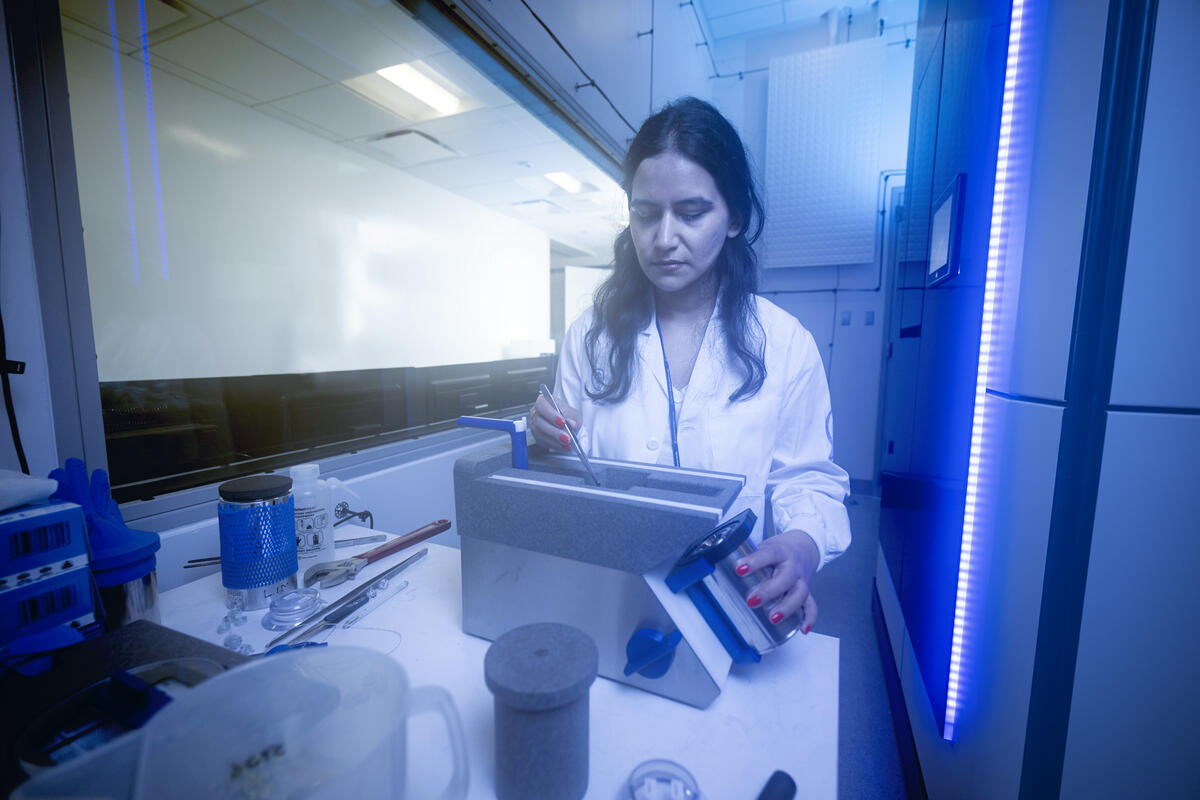
Ankita Dhar, a member of the Nikola Pavletich Lab, works at the sample loading station for the Krios G4 microscope.